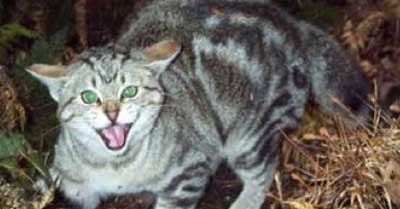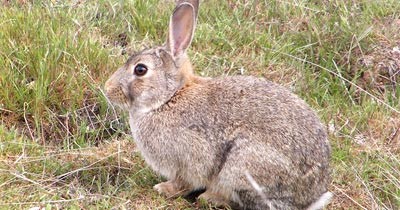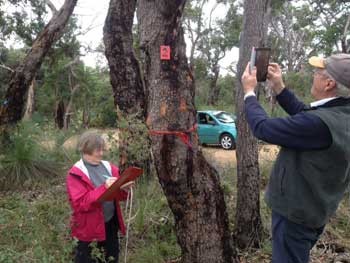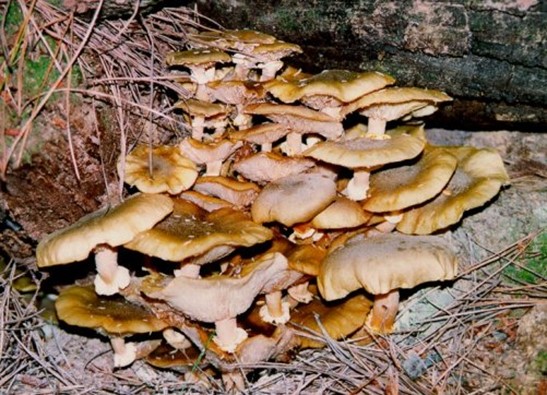Phytophthora Dieback
Phytophthora dieback is a disease caused by the introduced water mould Phytophthora cinnamomi. The water mould (fungus-like) kills susceptible plants by attaching to their root system and drawing off water and nutrients.
Dieback is a major threat to the Park, with approximately 40% of flora species considered as susceptible. Mapping has shown that approximately 25% of the Park is infested with phytophthora dieback, with 15% of the Park considered unprotectable (very likely to become infested). The main infected areas are waterways, areas adjacent to trails, Zone 6 and near Dunsborough and Eagle Bay. The remaining 60% of the Park is uninfested.
The movement of infected soil, plant material or water containing phytophthora dieback spores, particularly under warm, moist conditions, will spread the disease into uninfected areas. To prevent the spread of the disease, walkers must use the dieback hygiene stations located on trails throughout the Park. Mountain bike riders must use the dieback grids at the Endicott Loop and Dunsborough Districts and Country Club trailheads. Both walkers and mountain bike riders must stay on formed trails to minimise the spread of phytophthora dieback.
Other actions undertaken to prevent the spread of phytophthora dieback in the Park are:
- Regular dieback mapping and phosphite treatment at disease boundaries;
- Limestone sheeting of some firebreak access tracks and some existing trails;
- Installation of dieback markers to raise visitor awareness of dieback in the Park;
- Reducing water pooling on firebreaks;
- Treatment of infected trees by injecting and foliar spraying; and
- Ensuring that any works in the Park adhere to management guidelines.
More information on phytophthora dieback can be found on the Department of Biodiversity, Conservation and Attraction’s website and the Dieback Working Group’s website.
Bushfires
Fire are a constant feature on the Australian landscape and native plants and animals have evolved specific responses to fire events. Subsequently, most Australian ecosystems have developed specialised relationships with fire.
However, high intensity uncontrolled bushfires have a devastating impact on native flora, fauna and neighbouring property. The City of Busselton and the local volunteer bushfire brigades actively manage the risk of wildfire in the Park through control burning and firebreaks. Planned low intensity fires do not have the same long lasting effects as high intensity uncontrolled bushfires.
The Park experienced a major bushfire event in January 2022. Embers from a campfire sparked a blaze that burnt 200 hectares (40% of the Park) and forced evacuations in Dunsborough, Eagle Bay and Bunker Bay. The Park continues to recover but remains susceptible to further large bushfire events. Research continues to determine the long-term impact of the fire on soil fungi and vegetation health. See the link for a video taken two months after the fire.
Fire Management in the Park
Fire management is guided by an Ecological Fire Management Plan (8MB) and seeks to balance the protection of people and property with conservation values.
Consultation is regularly undertaken between the Meelup Regional Park Management Committee, City of Busselton, appropriate State Government departments and local volunteer bushfire brigades to identify appropriate fire mitigation activities, such as planned burns.
Weeds
Weeds are a serious threat to the biodiversity and amenity of Meelup Regional Park. Weeds originate from interstate, intrastate and overseas, compete with native vegetation for space, water, nutrients and can change the structure and composition of vegetation communities. In turn, habitat for native fauna is reduced. Weeds can significantly increase the fire fuel load and fire risk. In total, 91 species of weeds have been recorded in the Park.
Weeds can be declared under the Biosecurity and Agriculture Management Act 2007. Landowners who have a weed that has been declared under the Act have a legal obligation to control the weed on their property. See the full list of declared weeds under the Act here.
Many declared weeds are also Weeds of National Significance (WONS). WONS found in the Park include:
- Bridal creeper (Asparagus asparagoides)
- Arum lily (Zantedeschia aethiopica)
- One leaf cape tulip (Moraea flaccida)
See the full list of WONS here.
The term ‘woody weeds’ refers to large shrubs and trees such as the Sydney golden wattle (Acacia longifolia) which pose a very significant problem in the Park. Woody weeds are often prolific seeders, hard to remove and can significantly increase the fire fuel load within the area. They often spread from neighbouring properties where they are planted as screening buffers or feature trees.
The City of Busselton conduct an annual weed management program, utilising both contractors and volunteers. Contractors undertake chemical control (i.e. herbicides) and major works while volunteers hand-weed sensitive and high profile sites. Both contractors and volunteers undertake regular weed mapping to gauge the long-term success of the program. To learn more about volunteering in the Park please see (insert link to Get Involved tab).
The following criteria are used to prioritise areas for weed management within the Park:
- High use areas such as trails, firebreaks and coastal carparks
- Revegetated areas
- High Priority weeds e.g. Arum lily
- Historically disturbed sites e.g. old gravel extraction sites
Feral Animals
The main species of feral animals present in the Park are rabbits, feral cats and foxes.
The European red fox (Vulpes vulpes) was introduced to Australia for recreational hunting in the mid-1800s and has played a key role in the decline of many Australian animals. In Western Australia, foxes have contributed to the extinction of at least ten native animals. In the wider Geographe Catchment, foxes predate on the southern brown bandicoot, quokka, western ringtail possum and brushtail possum. The City of Busselton carry out a 1080 baiting program in Meelup Regional Park. Please see the Department of Biodiversity, Conservation and Attractions website for more information on the impact of foxes and management tools.


Domestic cats (Felis catus) are a key cause in the extinction and decline of numerous West Australian fauna species. Studies suggest that cats are should be classed into two groups based on their lifestyle: feral cats (including ‘stray cats’) and pet cats. The Park’s proximity to Dunsborough and Eagle Bay townsites place fauna within the Park significantly at risk from cats that are allowed to roam (feral cats). The City of Busselton manage feral cats through trapping and supporting initiatives like GeoCatch’s Catio Program.
Did you know?
- The term ‘ feral cat’ refers to any cat that is allowed to roam unsupervised, including stray cats and cats which are nominally owned by someone but are allowed to roam unsupervised. ‘Pet cat’ refers to cats that remain in the household and are cared for by people.
- Every day in Australia, cats kill an estimated 3.2 million mammals, 1.2 million birds, 1.9 million reptiles, 250,000 frogs and 3 million invertebrates
For more information on feral cats, please look at the Threatened Species Recovery Hub website.
The European Rabbit (Oryctolagus cuniculus) arrived in Australia with the First Fleet in 1788. Despite the Western Australian Government’s rabbit proof fence, feral rabbits had reached Western Australia by 1910. Feral rabbits have a devastating impact on native vegetation and the Australian landscape and are attributed with the extinction of several native Australian mammals.
Within Meelup Regional Park, rabbits impact the regeneration of native vegetation and compete with native animals for food. The City of Busselton controls rabbits through 1080 baiting, Rabbit Haemorrhagic Disease Virus (RHDV or calicivirus) and warren removal. To learn more about feral rabbits, please see the Department of Climate Change, Energy, the Environment and Water’s website.
Image: http://agriculture.vic.gov.au

Feral Animal Control
In order to protect native flora and fauna found within Meelup Regional Park, the City of Busselton carry out an annual feral animal control program, targeting foxes, feral rabbits and feral cats.
1080 (sodium fluoroacetate) is a compound that naturally occurs in native plants (Gastrolobium or poison peas). While toxic to feral and domestic animals, native Australian fauna have evolved high levels of tolerance to 1080. Signage advises visitors about the 1080 baits and neighbouring landowners are notified prior to any baiting occurring. 1080 is toxic and a danger to humans and domestic animals. Dogs are prohibited from Meelup Regional Park. For more information on 1080, please see the Department of Primary Industries and Regional Development’s website.
Rabbit Haemorrhagic Disease Virus (or calicivirus) is a biological control specific to European rabbits and will not harm other wildlife, domestic animals, livestock or humans. The City of Busselton carry out RHDV releases in spring and autumn annually. For more information please see the City's website.
Landowners adjacent to Meelup Regional Park are encouraged to undertake fox control on their properties to increase the effectiveness of control. Fox traps are available for loan free of charge from the City of Busselton and Geocatch. In rural areas, fox control advice can be sought from Department of Primary Industries and Regional Development (Ph: 9368 3333).
Images by: Animal Pest Management Services
Climate Change
The impact of climate change on Meelup Regional Park is uncertain. However, current rainfall levels are significantly lower than in 2000 and bushfires have increased in frequency (Zdunic and Huntley 2015). It is predicted that a decrease in rainfall will result in tree decline across the Park, which will be combined with a shift in species assemblage as vegetation responds to changed conditions. A predicted increase in the intensity of storm surges could impact the coastline of the Park through erosion and decrease the value of public amenities like Meelup Beach.
The storm surge in June 2018 caused considerable damage along the Geographe Bay shoreline, including Meelup Beach.
Other Threats
Uncontrolled Access
Uncontrolled access (vehicle, pedestrian and bike) can result in soil compaction, destruction of native vegetation, erosion, spread of weeds and dieback and disturbance to wildlife.
By keeping to parking areas, designated walk and bike trails this threat can be minimised.
Cankers
Marri canker (Quambalaria coyrecup) is a native fungal pathogen found in marri (Corymbia calophylla) within the Park. In response to infection, marri trees will produce an abundance of sap and wound-like infections will appear. In time, these wounds may ring-bark the tree, causing it to die. Marri canker may be more prevalent in disturbed areas, for example adjacent to carparks and roads. There is no known cure for marri canker but trials were undertaken to establish the effectiveness of phosphite and medical nutrient implants to boost the health of infected trees.
Different fungal infections resulting in cankers have also been identified as a major threat to Eucalyptus phylacis (Meelup mallee). For more information on marri canker see here and for more information on the Meelup Mallee see here.

Meelup Volunteers monitoring Marri trees in the park
Armillaria luteobubalina

Armillaria luteobubalina or Armillaria is a native fungus common to southwest Australia forests. In natural ecosystems, Armillaria is an integral part of ecosystem functioning. When changes or disturbances occur, Armillaria can spread and cause rapid plant death. The fungus has been identified across 16% of the Park.
Like Phytophthora cinnamomi, Armillaria attaches onto the roots of plants and causes root rot, often resulting in plant death. The fungus can then live on the dead plant’s tissue for many years. Armillaria symptoms include the death of branches, yellowing of foliage, poor vigour and the darkening and rotting of the larger roots. It spreads through root to root contact.
To prevent the spread of the disease, limiting new disturbances and maintaining biosecurity and hygiene when rehabilitating sites is important.